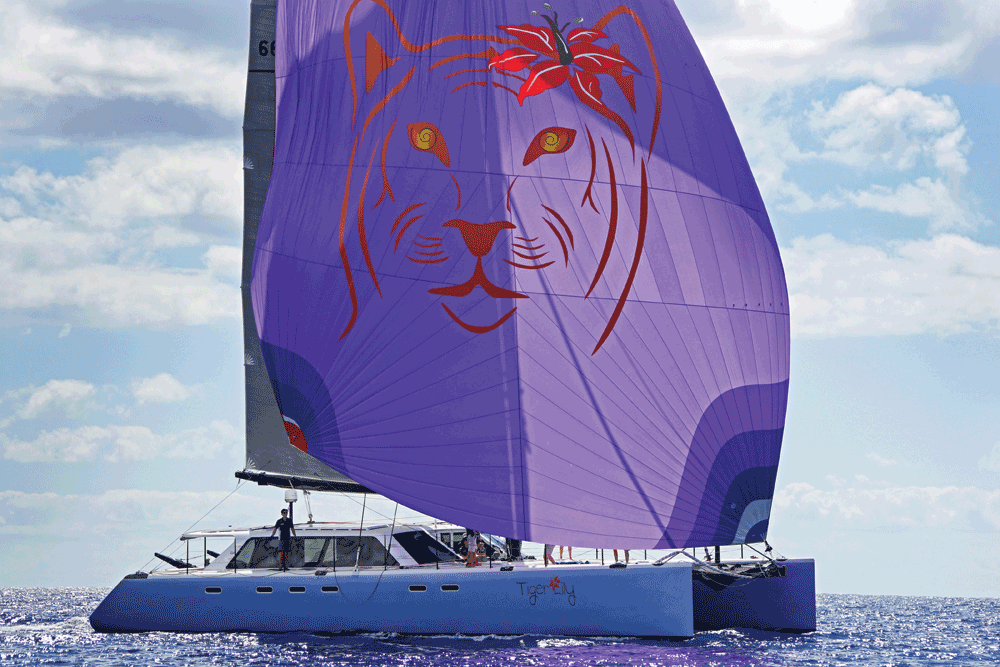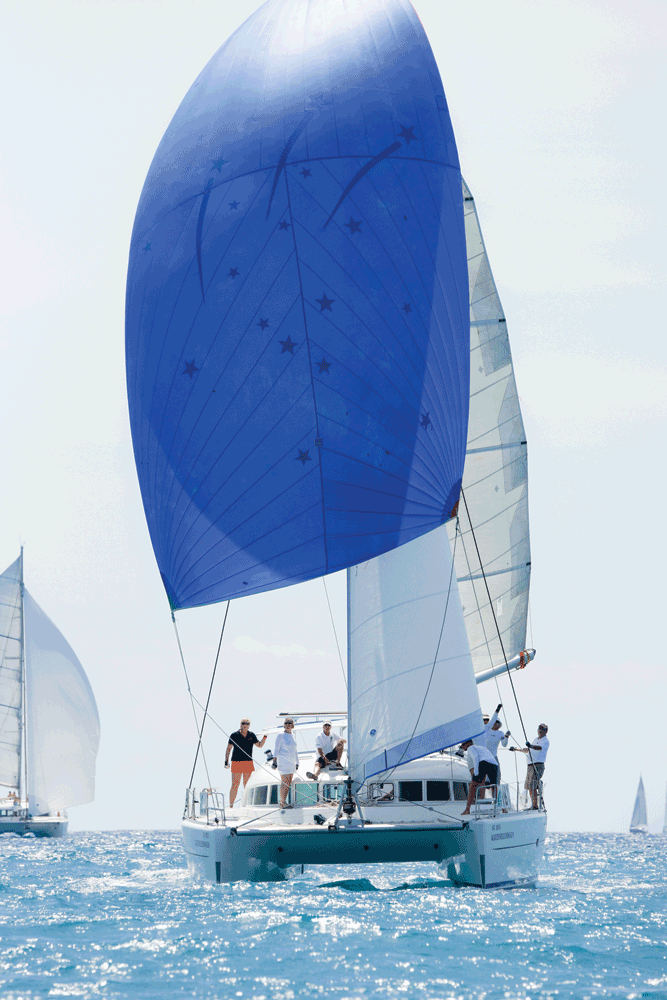Sailing down wind on a multihull
Find the right balance between angle and speed to make the most of off-the-wind sailing

All sailors are used to tacking upwind. And if you think about it, it seems fair that if you have to tack up wind, you should also have to tack down wind. But when your destination is straight down wind, it’s almost irresistible to resist the urge to aim right at it. The problem is that when it’s windy, dead down wind is dangerous, and when it’s light, it’s slow.
Symmetrical spinnakers keep the boat moving even in light wind. They sail deep downwind angles and can be launched and doused with a sock. On most multihulls they need no pole. Try your first experiments with this sail in light breeze without the mainsail set. You get a clear view of the sail and you find out sailing without the main can be quite relaxing. Jibing is as simple as turning the wheel a few degrees. Let it fly 3 to 5 feet above the deck and you’ll also notice it rotates to follow small wind or course shifts instead of collapsing. The solution is in tacking down wind. The formula is two-fold: Learn to jibe well and safely and get some big, light sails.
If you like tweaking strings for performance, put a sheet and guy on each clew. This allows you to fine-tune the sail’s shape. If you have a steady breeze and flat water, it can be the easiest set up you have. Just put it up and cruise for days, no hands.
The downside is complication: two lines on each clew, lots of blocks, cleats, clutches, winches. A sock adds two more lines. If spinnakers are built light and full enough to be powerful, they don’t like to reach very high, and they can be snarky to douse if you wait too long when the breeze is building.
Asymmetrical spinnakers, also known as gennakers or screechers, have only one clew and two sheets that connect to it. The tack is pegged. They can also launch with a sock, or they can roll up on a furler like a jib. Because they never quite roll up the same twice, the furler has to be the continuous-line variety, not a fixed-length furling line like those used with roller-furling genoas.
Asymmetrical spinnakers can be flown at deep angles if you put the tack down on the windward bow, rather than on the usual bowsprit in the center. This is another multihull gift: No pole is required, you just spread the sail out across the big wide bow and out of the lee of the main. Gennakers are normally smaller than symmetrical spinnakers. They also have the advantage of being able to reach high, which makes them easier to use and more flexible than their symmetrical cousins.

Reaching up on the wind with a gennaker brings us quickly to the whole point of tacking down wind: It’s fast. In fact it’s easy to get overpowered in a hurry with this sail, by just heading up a few degrees. Sail hot angles like this and you are aggressively altering your own apparent wind speed. When the boat speed jumps and the transom gets noisy you get a clear understanding of how racing cats are doing 40 knots in 20 knots of true wind.
Regardless of which kind of sail you use, it’s important to take into account how deep is it wise, comfortable, safe and smart to sail. How high do you have to sail to make the best use of the sails’ natural speed? It’s a math puzzle racing sailors fight about all day. The navigator wants to get to the mark and the driver likes to reach and go fast.
Reasonably priced instruments offer the information racers use every day. They calculate the best downwind angle for closing the gap between you and any waypoint. But they assume you are adept at jibing and don’t mind how many jibes you need to avoid hitting rocks, boats or beaches. They can put laylines on your chartplotter screen, just like America’s Cup television coverage, so you see the exact angle to sail, with predicted available speed for current wind strength, to beat your club mate to the barbecue.
If you sail too high, you find good speed but you’re going the long way home, adding extra distance. Too low is just slow prone to accidental jibes. When you’re sailing for performance, you steer and re-calculate constantly. But in relaxed cruising you are looking for an angle that requires the least fuss; the most efficient “set it and forget it” course. Sea conditions will have something to say about this, and you might find a few degrees off the high performance angle will make for a more comfortable ride.
Whether you’re looking for the last ounce of speed or the best balance for easy cruising, it’s not reasonable to plan on steering well for hours on end, especially with the concentration it takes to keep a spinnaker happy. A good autopilot is an important piece of cruising gear, and most modern autopilots offer the option of steering to apparent wind direction instead of compass heading. This function is valuable in downwind sailing, but trusting it takes time and practice.
Learn the details of this operation and practice using it in easy conditions. Always get the boat balanced and steering comfortably before you switch on the autopilot. If you’re overpowered and steering like a cement truck, rounding up and down, sawing the wheel like a logger, you shouldn’t expect the autopilot to like steering any better than you do. Find the right combination of sails and trim, then watch the autopilot like you would a newly set anchor. Don’t leave it alone until you trust it.
The autopilot, chartplotter, GPS and big sails are all helpful. They can help you tack downwind, sail fast and take away some drudgery and strain. But sailing well down wind takes a high level of sailing skill. Just like in dinghy sailing, it pays to master the basics. Feel the angle of the wind on the back of your ears and neck. Learn to read every visual clue; wind waves, blowing dust and flags, flocks of birds. Listen to the volume and tone of sound coming from your transom.
Plot wind angles with a pencil on a chart. It’s only vector geometry, but it tells you why another boat sailing a different angle keeps pulling farther away every time he crosses in front of you.
And when you want the best refresher course of all, jump in the smallest dinghy you can find, one tiller, one sheet, and go jibing downwind.

Comments